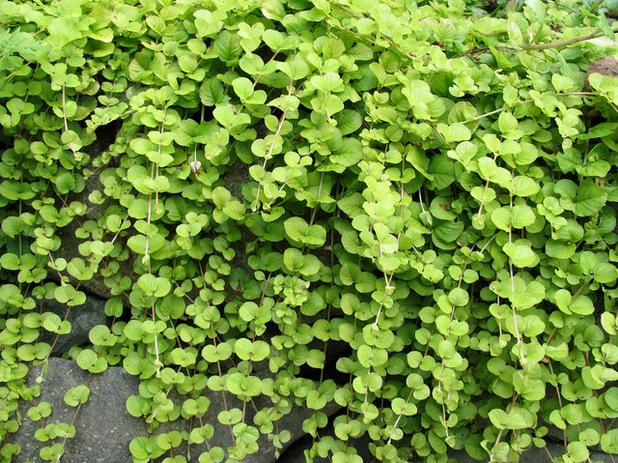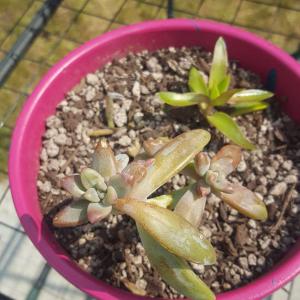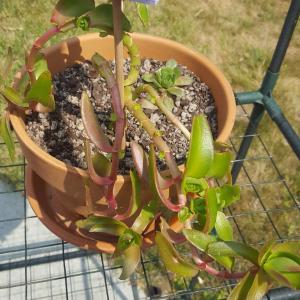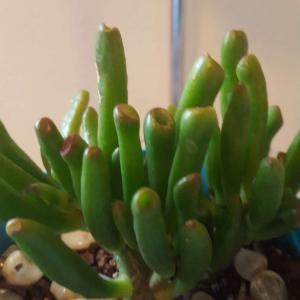文章
Dummer. ゛☀
2017年08月29日

Creeping jenny plant, also known as moneywort or Lysimachia, is an evergreen perennial plant belonging to the Primulaceae family. For those looking for information on how to grow creeping jenny, this low-growing plant thrives in USDA zones 2 to 10. Creeping jenny is a ground cover that works well in rock gardens, between stepping stones, around ponds, in container plantings or for covering hard to grow areas in the landscape.
How to Grow Creeping Jenny
Growing creeping jenny is relatively easy. Before planting creeping jenny, check with your local extension office to be sure that it is not restricted in your area due to its invasive nature.
Creeping jenny is a hardy plant that will thrive in full sun or shade. Purchase plants from nurseries in the spring and choose a site, in the shade or sun that drains well. Space these plants 2 feet apart, as they grow rapidly to fill in empty areas. Do not plant creeping jenny unless you are prepared to deal with its rapidly spreading habit.
Care of Creeping Jenny Ground Cover
Once established, creeping jenny plant requires very little up keep. Most gardeners prune this fast-growing plant to keep its horizontal growth under control. You can also divide the plant for better air circulation or to control spreading in early spring. Creeping jenny requires regular water and does well with a little organic fertilizer when first planted. Apply mulch or organic compost around plants to help with moisture retention.
What Is the Difference Between Creeping Charlie and Creeping Jenny?
Sometimes when people are growing creeping jenny plant, they mistakenly think it’s the same thing as creeping charlie. Although they are similar in many ways, creeping charlie is a low-growing weed that often invades lawns and gardens, while creeping jenny is a ground cover plant that is, more often than not, a welcome addition to the garden or landscape.
Creeping charlie has four-sided stems that grow up to 30 inches. The roots of this invasive weed form nodes where the leaves join the stem. Creeping charlie also produces lavender flowers on 2-inch spikes. Most varieties of creeping jenny, on the other hand, reach a mature height of 15 inches with yellow-green, coin-like foliage that turns bronze in the winter and has inconspicuous flowers that bloom in early summer.

How to Grow Creeping Jenny
Growing creeping jenny is relatively easy. Before planting creeping jenny, check with your local extension office to be sure that it is not restricted in your area due to its invasive nature.
Creeping jenny is a hardy plant that will thrive in full sun or shade. Purchase plants from nurseries in the spring and choose a site, in the shade or sun that drains well. Space these plants 2 feet apart, as they grow rapidly to fill in empty areas. Do not plant creeping jenny unless you are prepared to deal with its rapidly spreading habit.

Care of Creeping Jenny Ground Cover
Once established, creeping jenny plant requires very little up keep. Most gardeners prune this fast-growing plant to keep its horizontal growth under control. You can also divide the plant for better air circulation or to control spreading in early spring. Creeping jenny requires regular water and does well with a little organic fertilizer when first planted. Apply mulch or organic compost around plants to help with moisture retention.

What Is the Difference Between Creeping Charlie and Creeping Jenny?
Sometimes when people are growing creeping jenny plant, they mistakenly think it’s the same thing as creeping charlie. Although they are similar in many ways, creeping charlie is a low-growing weed that often invades lawns and gardens, while creeping jenny is a ground cover plant that is, more often than not, a welcome addition to the garden or landscape.

Creeping charlie has four-sided stems that grow up to 30 inches. The roots of this invasive weed form nodes where the leaves join the stem. Creeping charlie also produces lavender flowers on 2-inch spikes. Most varieties of creeping jenny, on the other hand, reach a mature height of 15 inches with yellow-green, coin-like foliage that turns bronze in the winter and has inconspicuous flowers that bloom in early summer.
0
0
文章
Dummer. ゛☀
2017年08月29日

Creeping jenny, also called moneywort, is a long, crawling plant that can spread very tenaciously. It is often mistaken for creeping charlie. Only reaching about 2 inches in height, this plant can grow to 2 feet long and has an unusually extensive root system. Once it’s established, it can be hard to get rid of and will crowd out or strangle plants that get in its path. Because of this, unless you specifically want it as groundcover in a spot where nothing else grows, you should work on controlling creeping jenny as soon as you spot it. Keep reading to learn more about how to get rid of creeping jenny in the garden.
Best Way to Manage Creeping Jenny
Creeping jenny control is not always easy, and it’s not always quick. If the plant is established in your yard, it may take two growing seasons to eradicate it. The best method of creeping jenny control is a combination of physically removing the plant and applying herbicides. Dig up every new plant you find and spray an herbicide, such as Roundup or Rodeo. New plants will emerge every few weeks – so keep pulling them up and spraying. Creeping jenny’s roots are very extensive and deep, so it will keep sprouting for quite some time. If you can, dig up plants before they flower, as failing to do so will result in lots of seeds and even more vigorous spread.
Another method of controlling creeping jenny is starving it of light. After digging up all visible plants, lay down a thick layer of mulch or black plastic. With any luck, this will keep the roots from putting up new shoots and eventually kill them. You might be able to achieve the same effect by filling the area with hardy plants well suited to the climate, like native grasses. These should put up more of a fight against the creeping jenny and help to block it from receiving light.

Best Way to Manage Creeping Jenny
Creeping jenny control is not always easy, and it’s not always quick. If the plant is established in your yard, it may take two growing seasons to eradicate it. The best method of creeping jenny control is a combination of physically removing the plant and applying herbicides. Dig up every new plant you find and spray an herbicide, such as Roundup or Rodeo. New plants will emerge every few weeks – so keep pulling them up and spraying. Creeping jenny’s roots are very extensive and deep, so it will keep sprouting for quite some time. If you can, dig up plants before they flower, as failing to do so will result in lots of seeds and even more vigorous spread.

Another method of controlling creeping jenny is starving it of light. After digging up all visible plants, lay down a thick layer of mulch or black plastic. With any luck, this will keep the roots from putting up new shoots and eventually kill them. You might be able to achieve the same effect by filling the area with hardy plants well suited to the climate, like native grasses. These should put up more of a fight against the creeping jenny and help to block it from receiving light.
0
0
文章
Dummer. ゛☀
2017年08月29日

Potentilla (Potentilla spp.), also called cinquefoil, is an ideal ground cover for partly shady areas. This attractive little plant spreads by means of underground runners. Its lemony-colored flowers that last all spring and strawberry-scented foliage make it irresistible.
Spring Cinquefoil Plants in Gardens
These plants are evergreen in mild climates. They grow 3 to 6 inches tall, with each leaf made up of five leaflets. Potentilla gets the name “cinquefoil” from the French word “cinq” which means five.
In spring, cinquefoil plants are covered with flowers that are one-quarter inch in diameter. The buttery-yellow to bright yellow flowers bloom over a long season if temperatures don’t climb too high. Propagate potentilla plants from seeds or by dividing the plants in spring.
You won’t want to grow creeping potentilla in gardens, where it quickly takes over an area. Instead, use it as a lawn replacement in areas with light foot traffic, in rock gardens, or in rock walls. Some gardeners use it as a ground cover in bulb beds. There are some lovely types of creeping potentilla that bloom in white and shades of orange and pink; however, the seeds to these varieties don’t always breed true. Since the plants produce seeds that fall to the ground and germinate, you may find these types reverting to yellow.
Growing Creeping Cinquefoil
Plant potentilla ground cover in full sun or partial shade. Some shade is best in areas with very warm summers. The plants thrive in average, moist but well-drained soil. Potentilla grows well in U.S. Department of Agriculture plant hardiness zones 4 through 8 as long as summers aren’t too hot. Water the plants well until they are established. Afterward, water often enough to keep the soil lightly moist. Water slowly and deeply each time, waiting until the surface is dry before watering again. The plants don’t need annual fertilization.
Potentilla has fine-textured foliage that looks good throughout spring and summer, and into the fall. If the plants begin to look ragged, set the mower blade as high as it will go and mow it down. It’s best to refresh the plants this way a couple of times each year. The foliage quickly regrows.

Spring Cinquefoil Plants in Gardens
These plants are evergreen in mild climates. They grow 3 to 6 inches tall, with each leaf made up of five leaflets. Potentilla gets the name “cinquefoil” from the French word “cinq” which means five.
In spring, cinquefoil plants are covered with flowers that are one-quarter inch in diameter. The buttery-yellow to bright yellow flowers bloom over a long season if temperatures don’t climb too high. Propagate potentilla plants from seeds or by dividing the plants in spring.

You won’t want to grow creeping potentilla in gardens, where it quickly takes over an area. Instead, use it as a lawn replacement in areas with light foot traffic, in rock gardens, or in rock walls. Some gardeners use it as a ground cover in bulb beds. There are some lovely types of creeping potentilla that bloom in white and shades of orange and pink; however, the seeds to these varieties don’t always breed true. Since the plants produce seeds that fall to the ground and germinate, you may find these types reverting to yellow.

Growing Creeping Cinquefoil
Plant potentilla ground cover in full sun or partial shade. Some shade is best in areas with very warm summers. The plants thrive in average, moist but well-drained soil. Potentilla grows well in U.S. Department of Agriculture plant hardiness zones 4 through 8 as long as summers aren’t too hot. Water the plants well until they are established. Afterward, water often enough to keep the soil lightly moist. Water slowly and deeply each time, waiting until the surface is dry before watering again. The plants don’t need annual fertilization.

Potentilla has fine-textured foliage that looks good throughout spring and summer, and into the fall. If the plants begin to look ragged, set the mower blade as high as it will go and mow it down. It’s best to refresh the plants this way a couple of times each year. The foliage quickly regrows.
0
0
文章
Dummer. ゛☀
2017年08月29日

Bunchberry (Cornus canadensis) ground cover is a petite ground-hugging perennial plant that reaches only 8 inches at maturity and spreads by underground rhizomes. It has a woody stem and four to seven leaves that are set up in a whorled pattern at the tip of the stem. Also known as creeping dogwood vine, pretty yellow flowers appear first followed by clusters of red berries that ripen midsummer. The foliage turns a beautiful burgundy red in the fall, making it a great addition to the garden for year round interest.
This showy evergreen ground cover is native to the Pacific Northwest and is particularly at home in moist soil and in shaded locations. If you live in USDA plant hardiness zones 2 through 7, you can enjoy the attractive bunchberry ground cover as it draws birds, deer and other wildlife to the area. Some people even eat the berries, which are said to taste a bit like apples.
How to Grow Bunchberry
Although bunchberry prefers shade, it will tolerate some light morning sun. If you have acidic soil, this plant will also be right at home. Be sure to add plenty of compost or peat moss to the planting area. Bunchberry dogwood plants can be propagated by seed or cuttings. Take cuttings below the ground level in mid July through August. If you choose to use seeds, they must be sown fresh in the fall or after they have had three months of cold treatment. Plant seeds 3/4 of an inch deep into the soil. Be sure the growing area is moist but also well-draining.
Caring for Bunchberry
It is important that creeping dogwood be kept moist and the soil temperature cool. This is one of the reasons why they do so well in the shade. If the soil temperature is above 65 degrees F., they can wither and die. Cover with a thick layer of pine needles or mulch for added protection and moisture retention. Caring for bunchberry is easy once they get started as long as you keep the soil moist and the plants receive plenty of shade. This ground cover has no known disease or pest problems, making it a truly easy keeper.

This showy evergreen ground cover is native to the Pacific Northwest and is particularly at home in moist soil and in shaded locations. If you live in USDA plant hardiness zones 2 through 7, you can enjoy the attractive bunchberry ground cover as it draws birds, deer and other wildlife to the area. Some people even eat the berries, which are said to taste a bit like apples.

How to Grow Bunchberry
Although bunchberry prefers shade, it will tolerate some light morning sun. If you have acidic soil, this plant will also be right at home. Be sure to add plenty of compost or peat moss to the planting area. Bunchberry dogwood plants can be propagated by seed or cuttings. Take cuttings below the ground level in mid July through August. If you choose to use seeds, they must be sown fresh in the fall or after they have had three months of cold treatment. Plant seeds 3/4 of an inch deep into the soil. Be sure the growing area is moist but also well-draining.

Caring for Bunchberry
It is important that creeping dogwood be kept moist and the soil temperature cool. This is one of the reasons why they do so well in the shade. If the soil temperature is above 65 degrees F., they can wither and die. Cover with a thick layer of pine needles or mulch for added protection and moisture retention. Caring for bunchberry is easy once they get started as long as you keep the soil moist and the plants receive plenty of shade. This ground cover has no known disease or pest problems, making it a truly easy keeper.
0
0
文章
Dummer. ゛☀
2017年08月29日

Nature has surprises around every corner, and the vegetable fern is a perfect example of this. What is a vegetable fern? Keep reading to learn more.
What is a Vegetable Fern?
The vegetable fern plant (Diplazium esculentum) is a species found and used in East to South Asia and Oceania. It is a cold sensitive plant suitable for the warmer regions and tender to freezing temperatures. Are vegetable ferns edible? You better believe it! It is an edible plant harvested and eaten in its native regions. The young fronds are the stars on this plant, as the tender young growth is a delicious addition to stir fries and other veggie rich dishes. Harvest them in early spring and use them as you would asparagus for nutrient dense and delicious wild eats.
Ferns of some type are very common in most regions. Their preference for moist, partially shady sites indicates that ferns are forest dwellers and, indeed, this is true for most species. The vegetable fern plant is a familiar food at markets in its native countries. The plant should not be confused with other varieties of ferns, however. It’s classified as Diplazium esculentum, which is a completely different species from look-a-likes such as Ostrich ferns. The vegetable fern plant is an evergreen that thrives on poor soils where there is plentiful moisture.
Vegetable Fern Info
Deplazium esculentum is grown from rhizomes as a harvest crop. The spores also freely implant in humus rich, moist soils. Distribution is widespread and even invasive in regions where there is plentiful heat, water and light shade. The plants prefer acidic soil and thrive in hot conditions. Most of the fern’s habitat is lower story forestry but it is also found in irrigation ditches and roadside gulleys. An interesting side note of vegetable fern info is its introduction to non-indigenous regions, where it has naturalized. It is something of a pest plant in areas of Florida and humid southern states of the United States.
Diplazium Esculentum Uses
You can find bundles of the crisp, yet tender, new fronds in Asian markets. In indigenous regions, Diplazium esculentum uses include light blanching as a leafy green vegetable, addition to stir fry or part of a soup or stew. The fiddleheads are also pickled. It is widely found in the Philippines and other parts of tropical Asia, such as India and the Bengals, as part of the daily diet. The fern is high in beta carotene and also contains a percentage of Vitamin E and riboflavin. The vegetable fern plant is a harvested crop that is either blanched, boiled or stir fried and, in some cases, pickled. Often compared to the flavor of over-cooked asparagus, the young fronds are generally cooked before consumption to avoid bitterness. Sometimes the fronds are dried and then reconstituted for cooking.
In India it is an essential ingredient in jhol curry and in the Philippines it is called Paku and a dietary staple. In Japan it is used in stir fry and bears the common name kuware-shida in the marketplace. Pickled, the curled new leaves are the basis for spicy condiments.
What is a Vegetable Fern?
The vegetable fern plant (Diplazium esculentum) is a species found and used in East to South Asia and Oceania. It is a cold sensitive plant suitable for the warmer regions and tender to freezing temperatures. Are vegetable ferns edible? You better believe it! It is an edible plant harvested and eaten in its native regions. The young fronds are the stars on this plant, as the tender young growth is a delicious addition to stir fries and other veggie rich dishes. Harvest them in early spring and use them as you would asparagus for nutrient dense and delicious wild eats.

Ferns of some type are very common in most regions. Their preference for moist, partially shady sites indicates that ferns are forest dwellers and, indeed, this is true for most species. The vegetable fern plant is a familiar food at markets in its native countries. The plant should not be confused with other varieties of ferns, however. It’s classified as Diplazium esculentum, which is a completely different species from look-a-likes such as Ostrich ferns. The vegetable fern plant is an evergreen that thrives on poor soils where there is plentiful moisture.
Vegetable Fern Info
Deplazium esculentum is grown from rhizomes as a harvest crop. The spores also freely implant in humus rich, moist soils. Distribution is widespread and even invasive in regions where there is plentiful heat, water and light shade. The plants prefer acidic soil and thrive in hot conditions. Most of the fern’s habitat is lower story forestry but it is also found in irrigation ditches and roadside gulleys. An interesting side note of vegetable fern info is its introduction to non-indigenous regions, where it has naturalized. It is something of a pest plant in areas of Florida and humid southern states of the United States.

Diplazium Esculentum Uses
You can find bundles of the crisp, yet tender, new fronds in Asian markets. In indigenous regions, Diplazium esculentum uses include light blanching as a leafy green vegetable, addition to stir fry or part of a soup or stew. The fiddleheads are also pickled. It is widely found in the Philippines and other parts of tropical Asia, such as India and the Bengals, as part of the daily diet. The fern is high in beta carotene and also contains a percentage of Vitamin E and riboflavin. The vegetable fern plant is a harvested crop that is either blanched, boiled or stir fried and, in some cases, pickled. Often compared to the flavor of over-cooked asparagus, the young fronds are generally cooked before consumption to avoid bitterness. Sometimes the fronds are dried and then reconstituted for cooking.

In India it is an essential ingredient in jhol curry and in the Philippines it is called Paku and a dietary staple. In Japan it is used in stir fry and bears the common name kuware-shida in the marketplace. Pickled, the curled new leaves are the basis for spicy condiments.
0
0
文章
Dummer. ゛☀
2017年08月29日

What is a rice paper plant and what’s so great about it? Rice paper plant (Tetrapanax papyrifer) is a shrubby, fast-growing perennial with gigantic, tropical-looking, palmate leaves and clusters of showy white flowers that bloom in summer and fall. This is a super-huge plant that reaches widths of 5 to 8 feet (2 to 3 meters) and heights of up to 12 feet (4 meters). Growing rice paper plants is a piece of cake if you live in a climate with relatively mild winters free of long, hard freezes. Interested in learning how to grow a rice paper plant in your own garden? Read on for more information.
How to Grow a Rice Paper Plant
Consider your climate and growing zone before planting. You can grow rice paper plants year round with no worries if you live in the warm climates of USDA plant hardiness zone 9 and above.
Rice paper plants grow in zone 7 and 8 (and maybe even zone 6) with plenty of mulch to protect the roots during the winter. The top of the plant will freeze, but new shoots will grow back from the rhizomes in spring. Otherwise, rice paper plants grow in full sunlight or light shade. Nearly any type of soil is fine, but the plants thrive (and spread faster) in rich, moist, well-drained soil.
Rice Paper Plant Care
Care of rice paper plants is easy. Just keep the plant well watered and provide a balanced fertilizer every spring. Spread a thick layer of mulch around the plant in late fall if you live north of zone 8. Extend the mulch at least 18 inches (46 cm.) beyond the shoots to ensure the roots are protected.
A note about aggressiveness: Rice paper plants spread vigorously by runners beneath the soil, with new plants often popping up 10 or 15 feet (3 to 4.5 meters) away from the original plant. You may have a real jungle on your hands if you allow the plant to spread unchecked. Pull suckers as they appear. Dig up new, unwanted plants and dispose of them or give them away.

How to Grow a Rice Paper Plant
Consider your climate and growing zone before planting. You can grow rice paper plants year round with no worries if you live in the warm climates of USDA plant hardiness zone 9 and above.
Rice paper plants grow in zone 7 and 8 (and maybe even zone 6) with plenty of mulch to protect the roots during the winter. The top of the plant will freeze, but new shoots will grow back from the rhizomes in spring. Otherwise, rice paper plants grow in full sunlight or light shade. Nearly any type of soil is fine, but the plants thrive (and spread faster) in rich, moist, well-drained soil.

Rice Paper Plant Care
Care of rice paper plants is easy. Just keep the plant well watered and provide a balanced fertilizer every spring. Spread a thick layer of mulch around the plant in late fall if you live north of zone 8. Extend the mulch at least 18 inches (46 cm.) beyond the shoots to ensure the roots are protected.
A note about aggressiveness: Rice paper plants spread vigorously by runners beneath the soil, with new plants often popping up 10 or 15 feet (3 to 4.5 meters) away from the original plant. You may have a real jungle on your hands if you allow the plant to spread unchecked. Pull suckers as they appear. Dig up new, unwanted plants and dispose of them or give them away.
0
0
文章
Dummer. ゛☀
2017年08月29日

If you’re looking for something different in the native plant or wildlife garden, then take a look at prairie dropseed grass. This attractive ornamental grass has much to offer in the landscape. Keep reading for more info and learn how to care for prairie dropseed grass. It may be just the thing you’re looking for.
What is Prairie Dropseed?
Prairie dropseed grass (Sporobolus heterolepis) is a North American native perennial bunch grass known for its bright green fine textured blades. Prairie dropseed plants sport airy pink and brown flowers in in late August through October. Their leaves turn an attractive orangey-rust mid-fall. Prairie dropseed plants love the sun. Their flowers have a distinct scent which is often described as smelling like cilantro, coriander or popcorn. Other prairie dropseed facts include: It grows 2-3’ x 2-3’ in size
It is drought tolerant after it is established
It is an excellent wildlife plant, as birds enjoy feasting on its seeds.
Growing Prairie Dropseed Plants
Growing prairie dropseed from seed requires patience and attention. It takes approximately 5 years to become fully established. Even though it is a drought tolerant plant, it requires regular irrigation for the first year. Care for prairie dropseed is minimal. It should be dethatched each year to remove the old, dead leaves. Make sure you plant this slow grower in full sun. Remove any weeds that compete for water and nutrients.
Prairie dropseed grass is an excellent ornamental plant and is very useful in landscape restoration projects. It is considered to be one of the showiest bunch grasses in the landscape industry. In addition to its low maintenance, the plant is basically trouble free. Now that you know a little more about prairie dropseed plants, perhaps you’ll choose to grow it as an addition in your landscape.

What is Prairie Dropseed?
Prairie dropseed grass (Sporobolus heterolepis) is a North American native perennial bunch grass known for its bright green fine textured blades. Prairie dropseed plants sport airy pink and brown flowers in in late August through October. Their leaves turn an attractive orangey-rust mid-fall. Prairie dropseed plants love the sun. Their flowers have a distinct scent which is often described as smelling like cilantro, coriander or popcorn. Other prairie dropseed facts include: It grows 2-3’ x 2-3’ in size
It is drought tolerant after it is established
It is an excellent wildlife plant, as birds enjoy feasting on its seeds.

Growing Prairie Dropseed Plants
Growing prairie dropseed from seed requires patience and attention. It takes approximately 5 years to become fully established. Even though it is a drought tolerant plant, it requires regular irrigation for the first year. Care for prairie dropseed is minimal. It should be dethatched each year to remove the old, dead leaves. Make sure you plant this slow grower in full sun. Remove any weeds that compete for water and nutrients.

Prairie dropseed grass is an excellent ornamental plant and is very useful in landscape restoration projects. It is considered to be one of the showiest bunch grasses in the landscape industry. In addition to its low maintenance, the plant is basically trouble free. Now that you know a little more about prairie dropseed plants, perhaps you’ll choose to grow it as an addition in your landscape.
0
1
文章
Dummer. ゛☀
2017年08月29日

Also known as striped and spotted wintergreen, Pipsissewa (Chimaphila maculata) is a low-growing plant distinguished by nodding, pale pink or waxy white blooms and forest-green foliage decorated with contrasting, creamy white stripes. This charming woodland plant isn’t difficult to grow and care of Pipssisewa plants is simple. Read on for more Pipsissewa plant info.
Growing Pipsissewa Plants
Pipsissewa plants are often gathered in the wild. Do your research first; the plants are vulnerable in some areas and may be protected by law. If harvesting Pipsissewa in the wild is acceptable, dig the rhizomes carefully from a large, healthy population. Take care not to disturb or trample the plant. If you’re lucky enough to have a friend with extra plants, you can easily start your own plants without threatening the native population. You can also propagate Pipsissewa plants by taking cuttings in June or by planting ripe seeds. The latter may not be the best option, however, as seeds often fail to germinate. If you decide to try propagation by seed, plant the seeds in moist peat moss mixed with a small amount of soil gathered from the area around the plant. With cuttings, it’s best to grow using some of the same planting medium from where it came, as the plant shares a mycorrhiza relationship for uptake of water and nutrients, and this will increase your chances of success.
Pipsissewa Uses in the Garden
Pipsissewa is a welcome addition to a wildflower or woodland garden, or as a ground cover in semi-shady areas. These plants also enjoy humus-rich soil similar to that found in wooded areas. Additionally, Pipsissewa leaves are edible and are often enjoyed for their crisp, refreshing texture, or brewed as tea, making them great additions for tea gardens too – as a word of caution, Pipsissewa wintergreen plants should not be confused with the wintergreen plant, Gaultheria procumbens.
Care of Pipsissewa Plants
Care of Pipsissewa plants involves keeping the soil relatively moist, as the plant doesn’t tolerate dry soil. Otherwise, this fuss-free little plant will grow for many years with no particular effort on your part.

Growing Pipsissewa Plants
Pipsissewa plants are often gathered in the wild. Do your research first; the plants are vulnerable in some areas and may be protected by law. If harvesting Pipsissewa in the wild is acceptable, dig the rhizomes carefully from a large, healthy population. Take care not to disturb or trample the plant. If you’re lucky enough to have a friend with extra plants, you can easily start your own plants without threatening the native population. You can also propagate Pipsissewa plants by taking cuttings in June or by planting ripe seeds. The latter may not be the best option, however, as seeds often fail to germinate. If you decide to try propagation by seed, plant the seeds in moist peat moss mixed with a small amount of soil gathered from the area around the plant. With cuttings, it’s best to grow using some of the same planting medium from where it came, as the plant shares a mycorrhiza relationship for uptake of water and nutrients, and this will increase your chances of success.

Pipsissewa Uses in the Garden
Pipsissewa is a welcome addition to a wildflower or woodland garden, or as a ground cover in semi-shady areas. These plants also enjoy humus-rich soil similar to that found in wooded areas. Additionally, Pipsissewa leaves are edible and are often enjoyed for their crisp, refreshing texture, or brewed as tea, making them great additions for tea gardens too – as a word of caution, Pipsissewa wintergreen plants should not be confused with the wintergreen plant, Gaultheria procumbens.

Care of Pipsissewa Plants
Care of Pipsissewa plants involves keeping the soil relatively moist, as the plant doesn’t tolerate dry soil. Otherwise, this fuss-free little plant will grow for many years with no particular effort on your part.
1
0
sheepdog:this plant grew wild under the pine trees on my land in SC!
文章
Dummer. ゛☀
2017年08月29日

Pampas grass is a popular landscape plant that is commonly seen in the home garden. Many homeowners use it to mark property lines, hide ugly fences or even as a windbreak. Pampas grass can grow quite large, over 6-feet with a 3-foot spread. Due to its size and numerous seeds, some people find pampas grass control a concern plus it is considered invasive in some areas. Thus, learning what kills pampas grass is important. Continue reading to learn how to remove pampas grass.
About Pampas Grass Plants
Pampas grass plants, native to Chile, Argentina and Brazil, are perennial grasses that grow immensely large with saw-toothed leaves and large pink or white, showy plumes. Although many home gardeners plant pampas grass for its elegant appearance and hardy nature, it can become a problem in some areas. The grass is not picky about soil or sunlight but does best in some sun and loamy soil. Pampas grass seeds freely and can eventually crowd out native plants. It can also create a fire hazard in some areas and interfere with grazing land. This is especially true in California, Africa and New Zealand where pampas grass is clearly recognized as an invasive plant. Each plant can contain up to 100,000 seeds per flower head that are quickly dispersed in the wind. Cutting the grass down in the early spring encourages new growth the following season and can sometimes alleviate issues with seeds. Caution must be taken when working with pampas grass, however, as the leaves are exceedingly sharp and can cause razor-like cuts.
How Can I Get Rid of Pampas Grass?
Some people try to remove pampas grass manually only to find that it has a massive root system. Digging the grass up is not an entirely full proof way to rid your landscape of the grass. The best possible pampas grass control involves a combination of physical and chemical methods. Because it is a grass, it is best to first cut it as close to the ground as possible. Once the grass is cut down, you can apply an herbicide such as Roundup. Several treatments may be necessary for established plants. For more information on what kills pampas grass, check with your local Cooperative Extension Office for advice.

About Pampas Grass Plants
Pampas grass plants, native to Chile, Argentina and Brazil, are perennial grasses that grow immensely large with saw-toothed leaves and large pink or white, showy plumes. Although many home gardeners plant pampas grass for its elegant appearance and hardy nature, it can become a problem in some areas. The grass is not picky about soil or sunlight but does best in some sun and loamy soil. Pampas grass seeds freely and can eventually crowd out native plants. It can also create a fire hazard in some areas and interfere with grazing land. This is especially true in California, Africa and New Zealand where pampas grass is clearly recognized as an invasive plant. Each plant can contain up to 100,000 seeds per flower head that are quickly dispersed in the wind. Cutting the grass down in the early spring encourages new growth the following season and can sometimes alleviate issues with seeds. Caution must be taken when working with pampas grass, however, as the leaves are exceedingly sharp and can cause razor-like cuts.

How Can I Get Rid of Pampas Grass?
Some people try to remove pampas grass manually only to find that it has a massive root system. Digging the grass up is not an entirely full proof way to rid your landscape of the grass. The best possible pampas grass control involves a combination of physical and chemical methods. Because it is a grass, it is best to first cut it as close to the ground as possible. Once the grass is cut down, you can apply an herbicide such as Roundup. Several treatments may be necessary for established plants. For more information on what kills pampas grass, check with your local Cooperative Extension Office for advice.
0
0
文章
Dummer. ゛☀
2017年08月28日

Dwarf mondo grass (Ophiopogon japonicus ‘Nana’) is a Japanese plant that has charmed the gardens of the world. A decorative, low growing plant, this plant looks best when grouped together but sometimes there may only be a few plants available. This is where dwarf mondo grass propagation comes in handy. There are two propagation methods available for dwarf mondo grass. One is planting dwarf mondo grass seeds and the other is division of your plant.
Dwarf Mondo Grass Seeds
If you decided to grow dwarf mondo grass seeds, be aware that they are finicky and you may have trouble getting them to grow. They may also not grow true to the parent plant. This is the more difficult of dwarf mondo grass propagation. Harvest seeds yourself and plant immediately. Seeds you buy will have a lower germination rate the less fresh they are. Plant your seeds in sterile potting soil and place the pots in a cold frame or other cool area. These seeds will germinate best in cooler temperatures. Keep the dwarf mondo grass seeds moist at all times. Wait two weeks to six months for seeds to germinate. They will germinate at irregular times. Some may sprout in two weeks, while others will take much longer.
Dwarf Mondo Grass Division
A much easier and sure fire way of dwarf mondo grass propagation is through division. This way you can plant dwarf mondo grass that is exactly like the parent and you will have a much more uniform look to your plants. For division, dig up a well established clump of dwarf mondo grass. Use your hands to break the clump into smaller clumps or use a sharp, clean knife to cut the clump into smaller clumps.
Plant the dwarf mondo grass clumps in the locations you would like them to grow in. Water them thoroughly and weep well watered for the first few weeks until them become established. The best time to divide your mondo grass in in the early spring or early fall.

Dwarf Mondo Grass Seeds
If you decided to grow dwarf mondo grass seeds, be aware that they are finicky and you may have trouble getting them to grow. They may also not grow true to the parent plant. This is the more difficult of dwarf mondo grass propagation. Harvest seeds yourself and plant immediately. Seeds you buy will have a lower germination rate the less fresh they are. Plant your seeds in sterile potting soil and place the pots in a cold frame or other cool area. These seeds will germinate best in cooler temperatures. Keep the dwarf mondo grass seeds moist at all times. Wait two weeks to six months for seeds to germinate. They will germinate at irregular times. Some may sprout in two weeks, while others will take much longer.

Dwarf Mondo Grass Division
A much easier and sure fire way of dwarf mondo grass propagation is through division. This way you can plant dwarf mondo grass that is exactly like the parent and you will have a much more uniform look to your plants. For division, dig up a well established clump of dwarf mondo grass. Use your hands to break the clump into smaller clumps or use a sharp, clean knife to cut the clump into smaller clumps.

Plant the dwarf mondo grass clumps in the locations you would like them to grow in. Water them thoroughly and weep well watered for the first few weeks until them become established. The best time to divide your mondo grass in in the early spring or early fall.
1
0
sheepdog:divide and conquer!













